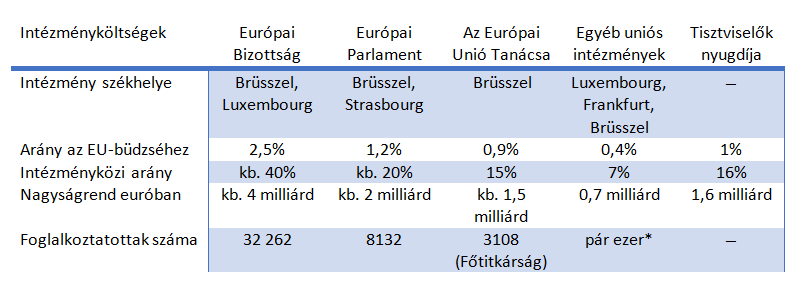Possibilities of budgetary control over the European Union and its institutions and the problem of sharing responsibility in the control system (part 2)
We have already heard a lot about how rigorously and institutionally the European Union controls the efficient, effective and corruption-free use of EU funds. How the governments of individual states manage the collected public funds is also a daily topic. But few have realized that the budget of the European Union itself is based on public money, and we have little information about how and who controls its use and how possible abuses are sanctioned.
Below, we present three key European Union institutions, the European Commission, the European Parliament, and the Council of the European Union (also known as the Council of Ministers) very briefly in terms of their main budgetary characteristics and employment data.
Budget ratio distribution among EU institutions
Administrative costs accounted for 5.6% of the European Union's in 2013 This amounted to approximately 8.4 billion euros, which is 1.8% higher than the amount of the previous year. Of this amount, 3.3 billion euros were spent by the European Commission, while 3.5 billion belonged to the other EU institutions. Projecting the expenses of joint institutions on the financial period 2014-2020 (multi-year framework), the ratios remain approximately the same. During the seven years, the total administrative costs will amount to 6.6% of the EU budget based on the previous forecast, and of this, 5.18% will be the expenses of the joint institutions.
The inter-institutional distribution of expenses – based on rounded ratios – was 40% for the European Commission and 20% for the European Parliament, compared to only 7% for the Council of the European Union and 15% for the operation of the other EU institutions. A significant cost ratio is represented by the pensions of EU officials with one-sixth (16%) and the costs of European institutional education. (The source of the figures described above: International Training Center for Public Service of the National University of Public Service: The EU's public administration rules. Educational resource, 2013.)
It is an important development that the European Union - especially during the crisis periods of the past fifteen years - has to manage the ever-increasing number of institutional, agency, etc. task costs, which puts even more emphasis on the effectiveness of financial control. This does not change the fact that the proportional distribution of common institutional costs has remained largely unchanged over the years and that the Commission bears the relative majority of such expenditure.
The European Commission
(Budget: approx. 4 billion euros in 2021, 40% of common institutional expenses, approx. 2.5% of the entire EU budget.)
The European Commission approximately 32,000 permanent and contractual employees, among whom are specialists, researchers, lawyers, translators and other specialists.
According to the place of employment, two-thirds of the Commission's employees work in Brussels (21,524 people, 66.7%), followed by Luxembourg (3,680 people, 11.4%), within the European Union, but another tenth of them in other cities (3,412 people, 10, 6%). The total, exact number of employees: 32,262 people.
As for higher-level executive salaries , the basic monthly salary of an EU Commissioner is 112.5% of the highest civil service grade, which amounts to €22,367.04 per month. The salary of the president of the Commission is already 138% (27,436.90 euros per month), that of the vice-presidents is 125% (monthly salary of 24,852.26 euros), in the case of the high representative for foreign and security policy, the ratio compared to the highest grade is 130% (25,846.35 euros earnings per month). The given grade is important for the annual update of the remuneration and pensions of officials and other employees of the European Union, as well as the correction coefficients .
The European Parliament
According to the website of the European Parliament, the annual budget of the parliament for 2021 was 2.064 billion euros, which corresponds to 20% of the common institutional expenses and 1.2% of the EU budget.)
The breakdown of the main cost categories is as follows:
• 45% – personnel (all personnel costs, contract employees, language services)
• 22% – operating costs (buildings, IT, administration)
• 26% – political activity (activities of EP members, individual representative groups, parties, foundations)
• 6% – communication (without language services)
according to a study carried out in 2013, the maintenance of the headquarters in Strasbourg means costs of around one hundred million euros, and according to the European Court of Auditors, 5 million euros are related to travel costs between the two headquarters (Brussels and Strasbourg).
The total number of employees in the Parliament was 8,132 in May 2022, of which 5,253 (64.6%) were in Brussels, 300 (3.7%) in Strasbourg, 2,291 (28.2%) in Luxembourg, and 288 (3.5%) in other locations .
The figures include officials, temporary and contract staff, and also include parliamentary group staff, but not MEPs' assistants. 13% of the Parliament's staff work for the parliamentary groups (which amounts to 1,093 positions).
The monthly pre-tax (i.e. gross) salary of MEPs is EUR 9,808.670 (as of July 1, 2022) according to The representative's salary comes from the budget of the European Parliament and is subject to EU tax and social security contributions, the salary after deductions (i.e. net) amounts to 7,647.13 euros.
The so-called general reimbursement is meant to cover the costs incurred in the Member State where the MEPs are elected, for example the maintenance costs of the MEPs' offices, telephone and postal costs, etc. The exact amount of this benefit - in 2022 - is 4,778 euros per month.
They also receive a separate allowance for travel expenses, so they can benefit from travel and accommodation expenses and other expenses in connection with their activities outside the Member State of their choice, up to a total annual threshold of 4,716 euros.
Pursuant to the provisions related to staff and parliamentary assistants, MEPs can choose their own assistants within the limits of the budget set by the European Parliament and under the conditions set out in Chapter 5 of the application rules of the MEPs' statute. In 2020, the maximum monthly amount available to MPs is €25,442, which covers the payment of their own staff.
Council of the European Union
budget of the Council, i.e. the Council of Ministers , was estimated to be around 1.5 billion euros for 2021, which corresponds to 15% of joint institutional expenses and 0.9% of the EU budget.)
The General Secretariat of the Council is the staff body responsible for supporting two EU institutions: the European Council (the body of heads of government and state) and the Council of the EU, the latter also known as the Council of Ministers, including its presidencies, the Committee of Permanent Representatives (Coreper) and other committees and working groups of the Council.
The General Secretariat currently has 3,108 employees: officials, temporary and contractual employees, and seconded national experts (this number corresponds to the data available on January 1, 2023).
The Council and the European Parliament adopt the annual budget of the European Union. The EU budget for 2023 amounts to €186.6 billion in commitments and €168.6 billion in payments. This part of the budget includes a separate section (Section II) for the shared (or joint) budget of the European Council and the Council. In 2023, this II. section accounts for approximately 0.35% of the EU budget. This represents approximately 5.7% of the total administrative expenditure of all EU institutions.
Main data of joint institutions (summary table)

* In the institutions of the European Union, a total of approx. 46 thousand people work.
The first part can be read here:
Use of public funds in the European Union - problems in control and division of responsibilities












